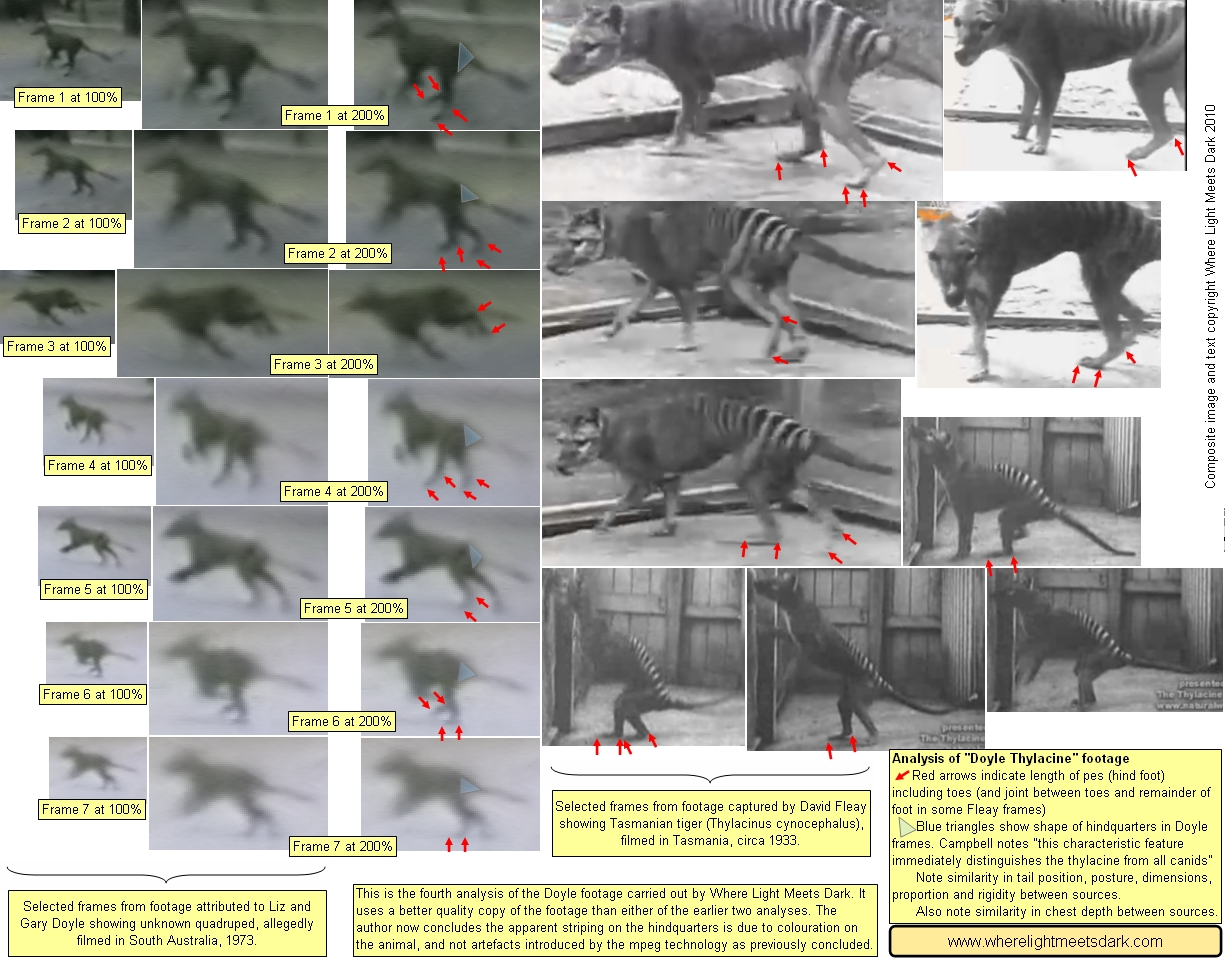Doyle thylacine - enhanced quality footage analysed
Overview
This article is the fourth in a series that examines the Doyle thylacine footage.
Enhanced footage received
In late 2009 I was supplied with a restored version of the Doyle footage. I do not have details to hand of the work which was carried out on the footage, but can source these if requested.
This analysis uses the best quality version of the Doyle footage that I have seen to date.
Analysis
This analysis is a straightforward comparison between frames from the Doyle footage and David Fleay's footage of a thylacine circa 1933.
The following key diagnostic features, visible in the Doyle footage, are those that most pursuade me to argue that the animal in the Doyle footage is a thylacine, albeit on the mainland of Australia circa 1973:
- The proportion of the pes (hind foot) relative to other bones in the hind legs and relative to the rest of the body
- The proportion and posture of the tail relative to the rest of the body
- The shape of the hindquarters
- The depth of the neck and chest
The above features can be directly compared with known thylacine images and footage. Unfortunately there is no known footage of a running thylacine, so the "kangaroo-like" posture exhibited in multiple frames cannot be attributed to the thylacine with any certainty. The posture does, however, align with descriptions of the thylacine resembling a kangaroo or wallaby.
It should be noted that there are additional frames, not included in this analysis, which also show the key features being highlighted here.
Conclusion
The higher quality footage re-enforces earlier conclusions that in numerous body proportions, the animal in the Doyle footage appears consistent with the thylacine.
Although one earlier analysis discounted the greyhound as a candidate, dogs (Canis lupus familiaris) assume an enormous variety of body shapes. Without rigorously comparing the Doyle footage with every known dog shape (and other canids including the red fox, Vulpes vulpes), we cannot conclude that the Doyle animal is not a dog. Despite this, the present analysis highlights two key distinguishing features on the Doyle animal which should discount the dog in general: the size and posture of the hind foot, and the shape of the hindquarters.
Although not demonstrated in the frames shown here, by inspection of all still frames in the higher quality source video, this author now concludes that the apparent striping on the Doyle animal is attributable to colouration on the animal and is not an introduced artefact resulting from the use of mpeg technology. Caveats to be added are that the exact steps carried out to enhance the footage have not been described and this author is not an expert in film and video analysis.
Irrespective of the animal's colouration, this author's conviction that the Doyle animal may be a thylacine is strengthened.
A note on South Australian thylacines
Robert Paddle (2000) and others have noted that there is documentary evidence that thylacines persisted in South Australia at the Flinders Ranges in the state's east until at least 1830 and possibly as late as 1850.
Australian Geographic magazine and others have described how a spate of thylacine sightings occurred in South Australia in the late 1960s and early 1970s from the south-east corner of that state as forest was cleared for farming.
Revisions
This article was first published at www.wherelightmeetsdark.com approx 2009 - 2010.
This article was migrated to www.wherelightmeetsdark.com.au in July 2017. This migration included:
- Overview added
- Minor changes
